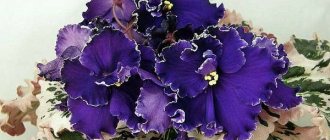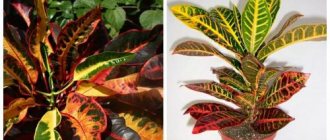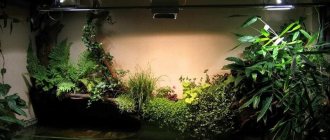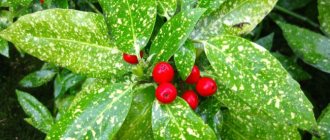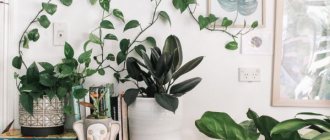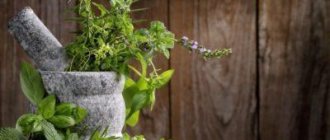Indoor plants are what add comfort and harmony to any home. Fresh flowers make a home more complete and enjoyable.
Monster
But if you want them to bloom and grow for a long time, you need to know their characteristics when planting and caring for them, because each plant with large leaves is different from each other.
Abutilone
There is a beautiful plant from the mallow family, also known as the indoor maple. And for good reason—these large-leaved, peaceful plants are something of an heirloom tree. Abutilon blooms with bright, large flowers that are pleasing to the eye and add elegance to any home. The flowering period is quite long - from May to October, so you can enjoy all this splendor. The plant loves warmth, about 20-30 degrees, but not lower than 15 degrees in winter. Water thoroughly and keep in a sunny location.
Reproduction methods
Propagation of an unpretentious plant is best done in the spring, when nature comes to life. Among the types of propagation that involve rooting are:
- cuttings;
- removal of sockets.
Cuttings
Cuttings must be at least 18-23 cm in length. They have aerial roots. This side shoot is cut off and immediately placed in the prepared soil.
Recommendations for propagation by cuttings:
The shoot is separated from the mother specimen with a knife wiped with alcohol. A large pot is being prepared. Drainage is laid out in the pot, and soil mixture for palm trees or peat soil mixed with sand is placed on it. The cutting is placed in the ground. The roots should not be completely in the soil. A pot with young pandanus is covered with a bag
It is important that there is a greenhouse temperature - about 30 degrees. Every day the sprout is opened and ventilated. Water once every 2 days. Rooting will occur in 50-80 days.
Removing sockets
Rosettes are formed on the mother plant in abundance. The collection takes place when the length of the daughter is at least 18 cm.
Rosettes in pots
Rosettes do not root right away
It is important to wait 12-18 hours so that the roots dry out a little. Afterwards they are placed in a pot of soil, as in the case of cuttings
Covering with film is also mandatory.
Seeds
Pandanus can also be propagated by seeds. This method is suitable for the Useful type. Seeds are sown in a substrate of river sand and high-moor peat. The planting is watered and covered with film. Ventilate and water once every 24 hours. The sprouts sprout within a month. After another 40-80 days, they can be transplanted into a separate container.
Evergreen spreading pandan will decorate a spacious apartment. Even a beginner can cope with its cultivation. Pandanus care is simple. The main thing is not to expose it to bright sun, not to overwater it or overdry it, and to feed it on time.
Avocado
Everyone has heard the name of this beautiful plant that came to Europe from America. Currently, avocado has become a common plant in Russia. Thanks to its large stature, it can grow up to 20 meters in height. It can be used as a houseplant or to decorate porches and outdoor patios. Indoors it can reach a height of up to 1 meter. Its elongated, long, thick leaves grow in a bush-like shape, making it an ideal addition to any corner of the home. Avocados love high humidity, so they should be watered frequently.
Exotic care
Pandanus care at home involves simple
This does not mean that you don’t need to pay attention to the plant at all. The florist should know that the palm tree with prickly leaves prefers freedom
For it it is necessary to allocate a corner with an area of at least 1.5 square meters. If the apartment is small, then as they grow, the long leaves will get in the way of the owners. In addition, other care points should be taken into account. Among which:
- soil composition, annual fertilizing;
- irrigation scheme, air humidity in the house;
- optimal temperature and lighting.
Soil composition, annual fertilizing
Typically, purchased soil marked “for palm trees” is used. It is allowed to prepare the substrate yourself. To do this, mix turf soil, leaf soil, sand, and humus. Each ingredient comes in equal quantities to the rest.
Annual feeding takes place over four to five months. In April, when the bush leaves the dormant period, it is fed with a mineral mixture. After 15 days, organic matter is added. It is allowed to use preparations that indicate “for palm trees, ficus”. Suitable organic materials include compost, humus, tea leaves, etc.
Fertilizers are applied twice in April, May, June, July, and August. The procedure is stopped in September.
Important! A pot for a screw palm should be made of natural materials. Its height is equal to its width
The container must be heavy and stable, due to the special power and weight of the exotic plant.
Watering, humidity in the apartment
The bush will grow well if it is watered in a timely manner. Due to its fleshy foliage, the indoor pandanus flower loves moisture.
Watering is carried out every 5-7 days. Settled water is used. The plant should not be watered with cold water.
During the dormant period, watering is carried out once or twice a month. The main thing is to prevent the soil mixture from completely drying out.
Exot should not be sprayed with water from a spray bottle.
The optimal humidity in the house is 60-80%. To do this, it is recommended to spray the air near the pandanus. This is done in the summer. You can place a container of water next to the tub. As it evaporates, it will humidify the air next to the tropical pandanus palm tree. Do not spray the plant itself with water from a spray bottle. In this case, moisture accumulates on the foliage. This can cause mold or a disease such as rot.
Optimal temperature and lighting
Pandanus also requires care regarding temperature conditions.
For good growth and health, the temperature should be +19...+27 degrees. Despite not being capricious, the plant will not survive if the temperature at home drops to +10 degrees.
Lighting for exotics should be moderate. It does well in a room with little shade. Pandans are not kept in complete darkness. Due to lack of light, its leaves lose their elasticity and rich color.
Note! Pandanus indoor plant definitely needs cleaning procedures. Dust accumulates on sheet plates
Every week you should remove dirt using a slightly damp cloth or sponge. Showering the plant is contraindicated due to the possibility of rotting.
Anthurium
One of the exotic and beautiful tropical plants, which is also called flamingo flower. It owes its name to its unusual and beautiful appearance. Many people often wonder how to find out the name of a houseplant with unusually shaped flowers. Anthurium is one of the most magnificent plants in the flower world. Its leaves are quite large and heart-shaped, and its flowers are unusual. They are bright and shiny and resemble little hearts. Anthuriums come in different types and colors, so you can choose a flower for any interior.
Transfer
The orchid is characterized by intensive growth of the root system, so the orchid needs to be replanted regularly. The container for transplantation should be chosen not deeper, but wider.
The transplant procedure takes place in several stages:
- Remove the orchid from the old pot and remove the old soil from the roots, cut off the rotten sections of the root system without damaging the healthy ones;
- The resulting sections need to be treated with charcoal or cinnamon;
- Place the flower in new soil.
After the transplantation procedure is completed, the plant should not be watered for the next 2-3 days.
Photo of the Cymbidium transplant process.
Alocasia
This large plant is also called elephant ear. It is not named so in vain, because it has no equal in the beauty and size of its leaves. Its dark-colored leaves are very large and flat. Alocasia grows quickly and can reach a height of 1.5 meters. Its beautiful shape and size make it an ideal ornamental plant for large areas. However, keep in mind that it is quite difficult to care for. Alocasia loves warmth and grows well at temperatures not lower than 18 degrees. It also requires constant soil moisture and fertilization.
Aspidistra
This plant is well known in the East and is widely cultivated in China and Japan. Due to its hardiness and undemanding nature, it is called the iron flower. It has almost no stems, and the leaves grow from the ground. Thanks to their thick, elongated shape, they look great in any room and create a cozy atmosphere. Aspidistra is easy to grow and very easy to care for. Plants should be kept out of direct sunlight as they are shade-tolerant. Ideal for decorating stairs and indoor corridors. Aspidistra is available in various varieties, both with plain leaves and as a houseplant with white-green leaves. A pattern of bright stripes runs along the entire length of the sheet in thin stripes.
Is it possible to keep a palm tree at home?
Pandanus is surrounded by myths and interpretations, and many people wonder: is it possible to keep a flower at home, what benefits or harm does it bring?
There is an opinion that keeping a palm tree in the house is harmful. Since ancient times, this plant was called a vampire - because of its thorns and curled leaves. Allegedly, they absorb energy, and allowing such a guest in your home is harmful for the whole family. The opposite opinion is that it is precisely due to its structure that the plant creates a protective barrier around the house and does not let in negative energy, cleansing the space.
There is a belief that evil people near such a plant become even more aggressive.
Contrary to this, there is a sign: if you want to stimulate an apathetic person to activity or develop a sharp mind in a child, give him a pandanus.
In nature, pandanus leaves are even used for medicinal purposes - they are chewed to relieve toothache or reduce gum inflammation. It is interesting that the owners of palm trees noticed: if they are transferred to another house, to another family, the plant immediately dies.
The only thing is that it is better to keep it away from pets, the thorns are unsafe for them.
What flower growers find particularly charming is the asceticism of pandanus. The flower does not require special care or constant attention, and pleases the eye like a real tropical miracle. True, you won’t see fruit in the interiors, but there will be plenty of lush greenery.
Dieffenbachia
Originally from Brazil, this plant has become popular in Europe due to its beautiful appearance and unpretentiousness. Dieffenbachia is easily recognizable among many other plants due to its exotic appearance. Its large, smooth leaves have unusual whitish-cream spots along their entire length. It is often used to decorate various rooms.
Dieffenbachia
Dieffenbachia is easy to care for. It can grow unhindered in a warm room without direct sunlight. With a lack of light, the leaves lose their color and the white spots become dull. Water sparingly and mist frequently.
Euro wood
Zamioculcas, dollar or euro tree are a worthy alternative to Crassula. Like the money tree, this plant is associated with money and wealth.
Zamioculcas has a lot in common with the Crassula:
- The stems of both plants are thick;
- the leaves are dense and fleshy, but on the euro tree they are more elongated and less juicy;
- both succulents do not require watering;
- always beautiful, evergreen, they rarely bloom, but they are spectacular even without flowers;
- toxicity - both plants are poisonous, but when working with zamioculcas you need to wear gloves because of the burning juice.
Unlike the crassula, the euro tree has a tuberous root.
Zamioculcas looks more stylish and laconic than the Crassula, so it fits perfectly into commercial interiors - this plant today can often be seen in the offices of large companies, banks, and other reputable institutions.
Maranta
This unusual and colorful plant grows in Central America. Arrowroot is one of the most wonderful plants that can be found in any home today. It is quite low-growing and short-stemmed, with beautiful, bright, oblong leaves. Bright burgundy and cream leaves run throughout the foliage, giving the flower a distinctive pattern. Maranta loves warmth and sunlight. Store at a temperature not lower than 18 degrees. Constant watering and spraying will ensure longevity for this plant.
And for a long time it will decorate any room with its unusual beauty.
Monstera
Monstera is another unusual and exotic plant brought to Europe from Central America. Monstera is easily recognizable among many other flowers due to its unusual appearance. Its large leaves are deeply cut and oblong in shape. Thanks to its beauty, Monstera has gained popularity among flower growers around the world. Since it is a tropical plant, it loves high humidity and warmth. Another distinctive feature of this flower is its aerial roots that grow above the soil. They should never be trimmed.
Hoya
Hoya is a genus of evergreen tropical plants, vines and shrubs, from the Kutrovaceae family. The most popular indoor species is Hoya fleshy. It is popularly known as wax ivy. Hoya resembles Crassula with dense leaves, fleshy and leathery. But its stem, unlike the Crassula, is thin and flexible.
But the main difference from the money tree is flowering. Hoya blooms almost non-stop - from spring to autumn. Its flowers are collected in inflorescences. The color can be different - there are countless varieties of hoya. The flowers are dense, glossy, and seem to be made of plastic.
Syngonium
The homeland of this plant is South America, but it has also taken root in Europe. Due to its unusual appearance and large size, syngonium has become quite popular. The plant has a long stem ending in beautifully shaped leaves. Syngonium belongs to the vine family and will grow tall and curl at the top of the plant if it finds support. The plant is quite undemanding and grows at temperatures not lower than 18 degrees. Wipe and spray the leaves daily, water, albeit moderately, but constantly. Excessive watering can cause leaves to rot. With proper care, the syngonium will decorate any home for a long time.
Apthenia
This creeping South African plant is a succulent, but, unlike them, it can bloom brightly and wildly. But this does not prevent it from being as hardy as the money tree and other succulents. Aptenia belongs to the small Aizov family.
The leaves of Aptenia are similar to Crassula; they are just as dense, fleshy, and glossy. But their shape is different - they look like hearts, and the color is juicy, bright green. Aptenia leaves are densely arranged on thick stems. The name of the plant translates as “a flower that opens its petals at noon.”
Scheffler
Native to Australia, this plant is popular for its tall growth and beautifully shaped leaves. Its decorative appearance will decorate any room and make it cozy and beautiful. Schefflera is also known as the umbrella tree. It gets its name from its long, thick stem that makes it look like a small tree, with small leaves that open out like umbrellas at the ends. The unusual shape of the leaves is one of the most characteristic features of this plant. Schefflera requires regular watering and tolerates shade.
Aeonium
Aeoniums are beautiful succulents and bright representatives of the Tolstyankov family. They have leaves very similar to the money tree, they are also unpretentious and tenacious. The main difference between plants is the arrangement of leaves.
Aeoniums, unlike Crassula, have leaves arranged in rosettes of different shapes. The money tree has all the leaves of the same green color, while the leaves of the aeoniums have a varied range of shades - the green color can have a variety of undertones, from pink to deep black.



